The premier method of measuring hardness for flexible and semi-rigid materials is the Shore Hardness Scale. A seemingly confusing system of numbers and letters that defines the relative toughness of materials. This article fully explains the mystery of the Shore Scale and its importance to manufacturing.
What Is Shore Hardness Scale?
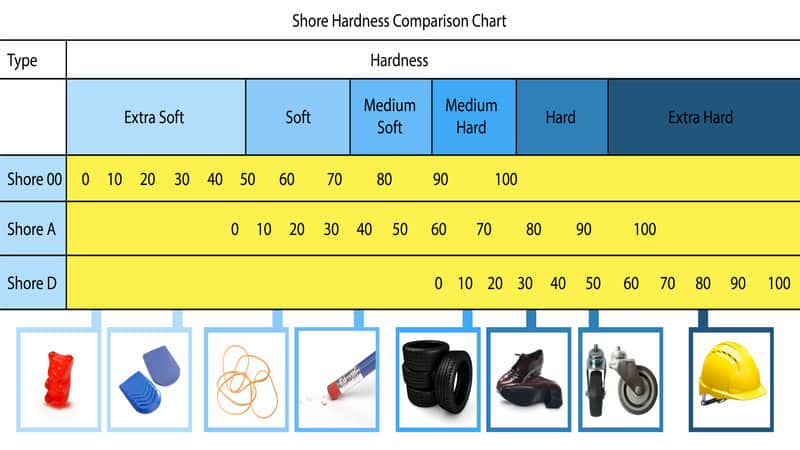
The Shore durometer is an instrument used for measuring the material’s hardness, generally rubbers, semi-rigid plastics, hard plastics, and thermoplastic elastomers. The device used to carry out the shore hardness test is called a shore durometer, or shore hardness scale. The hardness value is determined by the penetration of the Durometer indenter foot into the sample.
The shore hardness scale uses a combination of letters and numbers to classify different types of materials. Rubbers and plastics come in several forms, ranging from rigid to soft. The durometer hardness scale illustrates material hardness relative to other material types.
There are different Shore Hardness scales for measuring the hardness of different materials, such as soft rubbers, rigid plastics, and supersoft gels. These hardness scales were created so that everyone could discuss these materials and have a common point of reference for them.
How do you Calculate Shore A Hardness?
The Shore A hardness measurement is called a ‘’durometer”. The shore hardness is calculated by pressing a spring-loaded steel rod with a conical tip into the material. Depending upon how far the road indents itself into the material, a hardness rating between 0-100 is assigned. For example, softer compounds that offer less resistance are ideal for low-pressure seals where the material must conform to rough or uneven surfaces. In contrast, harder materials are more appropriate for high-pressure seals.
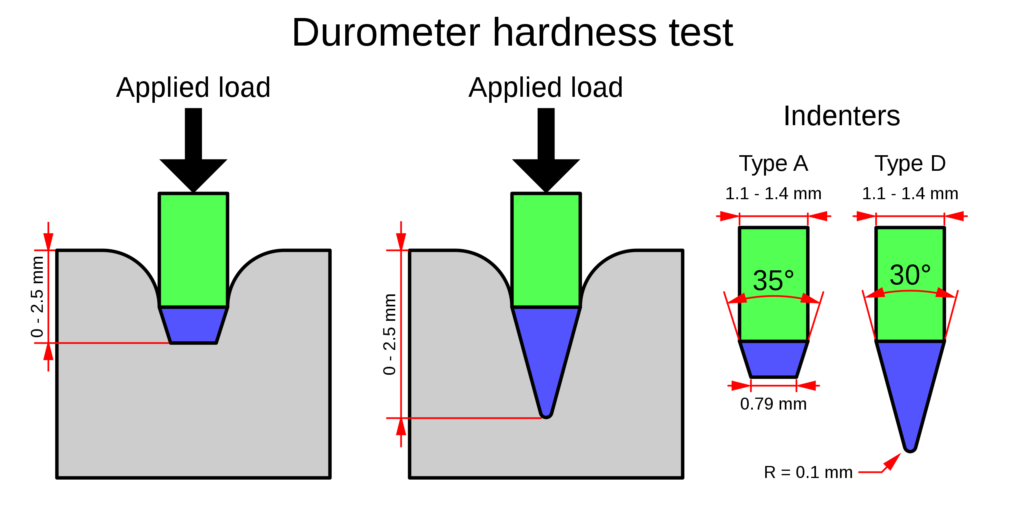
Following are the testing criteria for the shore durometer hardness test.
- Steel Rod Diameter: 1.1 mm to 1.4 mm
- Rod Tip Angle: 35°
- Tip Diameter: 0.79 mm
- Applied Force: 8.064 N (822 g)
The format for shore scale labeling is a number first, then the word “shore,” and finally, the type of testing. For example, a standard O-ring has a durometer value of 70 Shore A. “70” shows the relative hardness of the material relative to other materials tested. “Shore ” represents the test methodology, and “A” shows the sub-type of shore testing.
Take the First Step:
Requst for an Inquire
Quality Meets Affordability. Inquire Now for High-Quality Products at Low Volumes.
Shore Hardness Scales
The numbers on a shore hardness scale are directly linked to material hardness. Here, higher numbers indicate a higher hardness value. In contrast, the letters are an indication of the test method. The Shore A hardness (durometer) scale is one of many durometer scales used to measure material hardness. There are 12 shore hardness scales, represented by the letters A, B, C, D, E, M, O, OO, DO, OOO, and OOO-S, and Shore OO, O, B, C and H are rare within the plastics and rubber industry.
Shore A and Shore D are the two most commonly used scales for measuring rubber hardness. The numbers on a shore scale are directly linked to material hardness. Here, higher numbers indicate a higher hardness value. While the letters are an indication of the test method. There are 12 shore hardness scales, represented by the letters A, B, C, D, E, M, O, OO, DO, OOO, and OOO-S.
Shore or Type A and Type D are the two most prominent scales for measuring material hardness for rubbers, plastics, and nonmetals.
Shore A

Shore A scale is used for soft materials with relatively high flexibility, like semi-rigid plastics or soft silicone rubber. This scale uses a gram force of 822 g (~1.8 lbs) to push a steel rod into the test sample. You need to use an appropriate force for softer materials, as too much force will pierce through the material.
Commercially you will find durometer scales with Type A printed on them. These are shore A scales and will give you a shore rating when you press them against a material surface.
Example:
- Rubber band generally has a durometer hardness rating of 25 Shore A scale.
- A tire tread has a hardness of 70 A while a leather belt can have a hardness of 85 A.
- A Soft wheels of roller skates & skateboards 75 Shore A
Shore D
The Shore D classification is used for determining the hardness of more rigid materials with very little flexibility. Common materials associated with the Shore D scale include hard vulcanized rubbers, semi-rigid plastics, and rigid plastics. This scale uses a gram force of 4536 g (~10 lbs) to push a steel rod into the test sample.
Example: Truck tires have a standard durometer hardness rating of 55 Shore D.
Shore OO
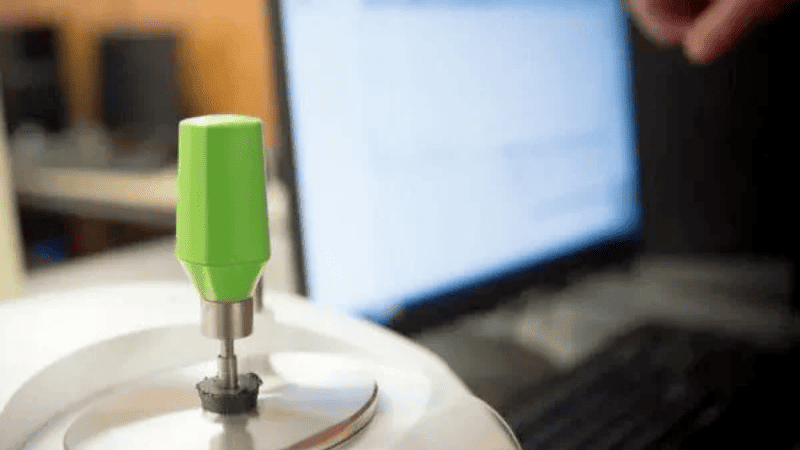
Shore OO is one of the less common scales for measuring shore hardness. It measures the softest materials like rubber gels and soft-touch rubber. Materials tested on the Shore OO scale are so soft that any large force would damage the test samples. Hence, this test is conducted using a small gram force of 113 g (~0.25 lbs).
Shore Durometer Hardness Test Example: Bubble gum has a durometer hardness rating of 20 Shore.
Shore Scale Conversion

Some materials that lie between soft and rigid can be tested using both Shore A and Shore D scales. In such cases, you can use a simple conversion table to determine the Shore A scale value corresponding to the Shore D scale. This conversion can also be applied to all the shore hardness scales, though compatibility is more limited.
These hardness scales were created so that everyone could discuss these materials and have a common point of reference for them.
Take the First Step:
Requst for an Inquire
Quality Meets Affordability. Inquire Now for High-Quality Products at Low Volumes.
Importance of Shore Hardness
The shore or durometer scale holds a significant role in material evaluation. The shore hardness of different materials dictates their compatibility with different products. You can test hard materials like metals and ceramics using Rockwell, Brinell, or other tests. You only have the shore scale to measure softer plastics and rubber hardness.
The widespread adoption of rubber and plastic products has led to an influx of various material formulations. Categorizing these materials is important from an engineering and manufacturing perspective. Several different forms of rubber materials are available in the market, and we need scientific ratings to distinguish between them.

Rubber hardness also represents material strength and flexibility; higher shore values mean more robust materials but lower flexibility. Rubber is primarily used for its flexible nature, but strength is the desired property for products. The shore hardness scale helps create a clear distinction between materials and allows manufacturers to choose the suitable material for the job.
From a product standpoint, you need to consider two things longevity and application. You should always use more challenging material options for the long life span of materials. Materials with a rating of 50 Shore D or higher will last several decades and only degrade after excessive abrasion and rough use. But this does not mean all consumer products should be made from such hard rubbers and plastics.
We also need to consider the use case for these products. Children’s toys need to be safe to use, and the best way to ensure toy safety is to use softer materials. A rubber doll should be made from flexible mold rubbers that rank ~50 Shore A on the durometer scale. This is the same shore hardness as a pencil eraser.
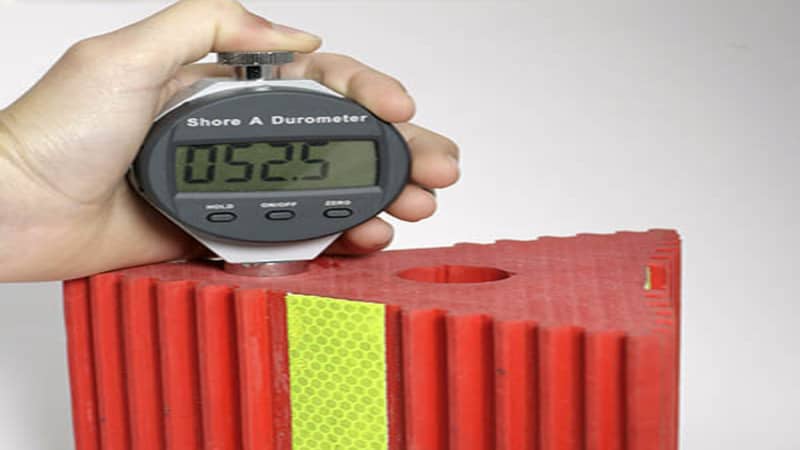
Shore Hardness Scale Examples
Shore OO is used for very soft materials, and though it can be used to classify various products, it is commonly used as a reference for foods. Soft food and snacks like marshmallows or gummy bears hover around 10 Shore OO on the durometer scale. Non-food products like gel insoles are around 30 Shore OO.
Shore A scale has a much more comprehensive range of products under its umbrella. Food products like bubble gum are made from soft materials at 20 Shore A scale. While leather belts can go up to 80 Shore A scale. Ebonite rubber is at the peak of the type A scale, with an average rating of 100 Shore A scale. Some soft plastics can be tested using the type A scale, but it is uncommon.
Shore D also has a wide range of products and materials. But unlike type A, many more plastics are listed here. Plastic materials like HDPE are often used for manufacturing hard hats. They have an average value of 75 Shore D. Additionally, you will find that many wood and paper products are also measured using the Type D scale. Wooden rulers are approximately 70 Shore D, while textbook covers are 40 Shore D.
The following is a simple table of standard shore hardness scales and their associated materials and products.
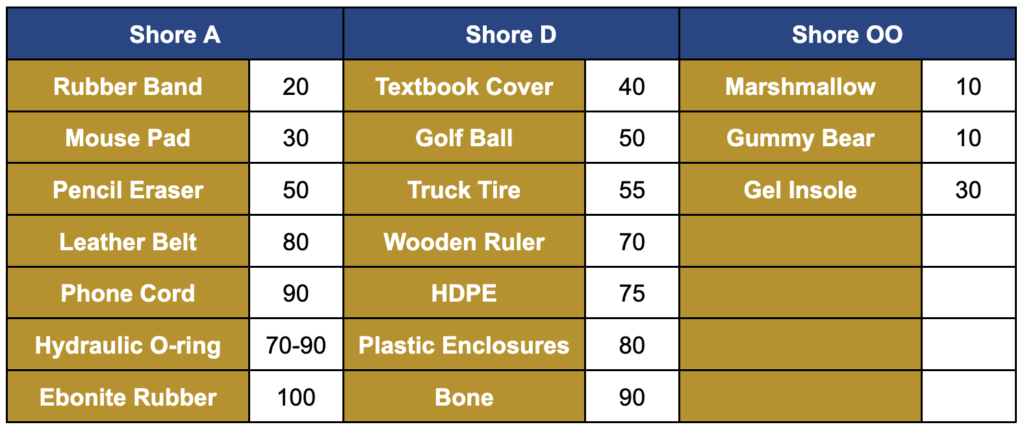
Take the First Step:
Requst for an Inquire
Quality Meets Affordability. Inquire Now for High-Quality Products at Low Volumes.
Conclusion
Shore Hardness is an easy way to measure a material’s relative rigidity and flexibility. Initially, you may find the complex labeling scheme to be daunting. But it becomes much easier to comprehend once you understand the simple logic behind the shore hardness scale system.
The Shore A hardness scale is widely used in the polymer and plastics industry to characterize the hardness of various materials. Measuring material hardness can also be beneficial to performing maintenance on your system’s materials. You can find a rubber durometer gauge in most hardware stores if you want to confirm the Shore rating.
Why Rely on Hongju for Your Rubber Products?
Hongju is a leading manufacturer of silicone rubber products. We offer several shore grades of rubber materials for OEM and ODM services. We have excellent Compression Molding, Rubber Molding, and Die-Cutting machines operated by our expert craftsmen. The cherry on top of our excellent services is our low MOQs and quick turnaround times. We can deliver a prototype using CNC machining within 3-5 working days.